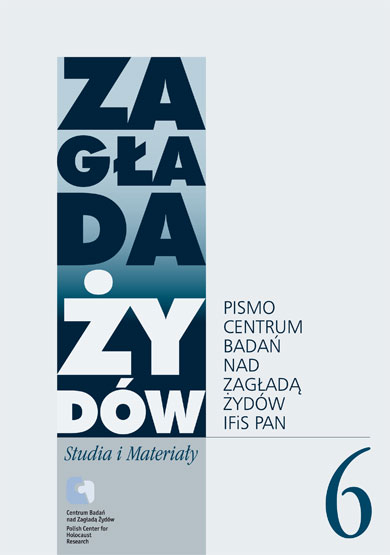Lagry w perspektywie genderowej
Zagłada Żydów. Studia i Materiały, Nr 6 (2010), Strony: 193-204
Data zgłoszenia: 2020-12-06Data publikacji: 2010-12-30
 https://doi.org/10.32927/zzsim.716
https://doi.org/10.32927/zzsim.716
Abstrakt
The questions of corporality, sexuality, women’s experience and their record examined in the context of camp issues and the Holocaust have only recently become the subject of attention. Gender studies play a significant role in the discussion on those issues. Existing works on the subject (i.a. the book of Bożena Karwowska Ciało. Seksualność. Obozy zagłady [Gender, Sexuality, Concentration Camps]) show that the tools of gender studies are cognitively useful, but, as it appears, their role of being particularly predestined to uncover what is marginalized or condemned to silence is overestimated. Nevertheless, apart from the dominance of the patriarchal discourse, there have always existed other reasons for suppressing the matter of corporality and sexuality both in works on KL’s and in science; social taboo (controlled not only by the male symbolical order) as well as the policy (e.g. it was possible to
write openly about rape on former female prisoners by Soviet soldiers only after censorship had been lifted) play an important role here. The fundamental value of the gender perspective lies in the firm approach towards the issues hitherto marginalized in the KL context – both by science and, to a lesser extent, literature (which is reflected by i.a. works of Pankowski and Posmysz published years ago).
Licencja
Prawa autorskie (c) 2010 Autor&"Zagłada Żydów. Studia i Materiały"

Utwór dostępny jest na licencji Creative Commons Uznanie autorstwa 4.0 Międzynarodowe.
https://creativecommons.org/licenses/by/4.0
Czasopismo publikowane jest w standardzie Diamond Open Access na licencji CC-BY-4.0 Deed - Uznanie autorstwa 4.0 Międzynarodowa - Creative Commons
Podobne artykuły
- Jacek Leociak, Geographies of the Holocaust, red. Anne Kelly Knowles, Tim Cole, Alberto Giordano, Bloomington–Indianapolis: Indiana University Press, 2014, 260 s. , Zagłada Żydów. Studia i Materiały: Nr 14 (2018)
- Aleksandra Ubertowska, The Comforting Power of Kitsch. The (Esthetic) Meanders of Holocaust Literature , Zagłada Żydów. Studia i Materiały: 2010: Holocaust Studies and Materials
- Piotr Trojański, „Trzeba mu jedną posłać, bo jakiś złotnik czy też kanadziarz”. Sprawa strażnika Stałej Ochrony Obozu Oświęcimskiego , Zagłada Żydów. Studia i Materiały: Nr 11 (2015)
- Joanna Nalewajko-Kulikov, Three Colors: Grey Study for a Portrait of Bernard Mark , Zagłada Żydów. Studia i Materiały: 2010: Holocaust Studies and Materials
- Bartłomiej Rusin, Deportacja Żydów z Macedonii Wardarskiej, Bełomoria i Pirotu w historiografii bułgarskiej , Zagłada Żydów. Studia i Materiały: Nr 11 (2015)
- Roni Stauber, Filip Friedman i początki badań nad Zagładą , Zagłada Żydów. Studia i Materiały: Nr 11 (2015)
- Michał Komar, Władysław Bartoszewski in memoriam , Zagłada Żydów. Studia i Materiały: Nr 11 (2015)
- Karolina Sulej, Jacek Leociak, „Uśmiechał się do mnie i przesyłał mi ręką pocałunki”. O relacji Dory Sztatman , Zagłada Żydów. Studia i Materiały: Nr 5 (2009)
- Sławomir Buryła, Nechama Tec, Daniel w jaskini lwa. Życie Oswalda Rufeisena , Zagłada Żydów. Studia i Materiały: Nr 5 (2009)
- Nawojka Cieślińska-Lobkowicz, Centrum Dokumentacji Nazizmu w Monachium i obywatelska pamięć Niemiec , Zagłada Żydów. Studia i Materiały: Nr 12 (2016)
<< < 1 2 3 4 5 6 7 8 9 10 11 12 13 14 15 16 17 18 19 20 21 22 23 24 25 > >>
Możesz również Rozpocznij zaawansowane wyszukiwanie podobieństw dla tego artykułu.
 English
English
 Język Polski
Język Polski




